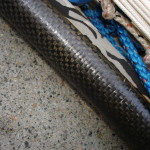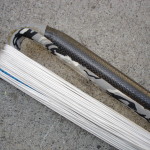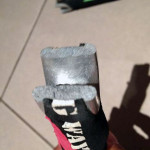10 years ago, kite brands, shops and local riders claimed that carbon control bars were stronger, stiffer and lighter than aluminum.
Fast forward to 2014 and you will struggle to find anyone even considering a carbon control bar.
So what happened?
In late 1999/2000, everyone was flying 2 line kites with a harness line in the middle to attach yourself to the kite. This put a huge amount of strain on the bar so we had to use thick aluminum, which made it tricky to fly the kite with one hand.
To combat this, we started ordering lengths of thin carbon tubing from Fiberspar who made windsurfing booms at the time. We would then cut the carbon to size, wrap it in hockey tape and tie the leader lines to the end of the bar.

Then 4 line kites came along and suddenly you had to have a hole in the middle of the bar. This added an extra dimension that the carbon just couldn’t cope with. Various manufacturers were using carbon to make their 4 line control bars but they were breaking!
Threads like this started appearing on various kite forums and that wasn’t the only problem.
According to Julien Fillion (Liquid Force Kites designer), “You have to use very thick carbon on those hollow carbon tubes, which raises the price and the weight. The loss of weight is so small when you use carbon and the price is exponentially higher, which is translated directly into the retail price of the bar!”
What’s in a bar now?
Most brands now use a solid Aluminum bushing surrounded by an Aluminum hollow tube. Aluminum is very reliable and consistent. For their CPR control bar, Liquid Force were able to find a very high breaking force, more than 400kg. The strength to weight ratio of this method is excellent allowing designers to make thin, strong bars that stand the test of time.
Old Bars Can Break
Although modern day kite bars are built to last, they don’t last forever! So if your bar has some miles on the clock, maybe its time to upgrade…





